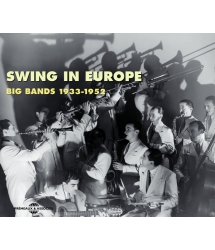This may not be a truly representative survey of big band swing in Europe but it is certainly an entertaining and thought-provoking collection. The compilers admit in the accompanying booklet that they were dependant on finding good quality (musically and sonically) 78s which ruled out, for example, Finland, Hungary and Austria where there were active swing bands but minimal recording. Otherwise, all the major European countries, including some Eastern European ones, are covered with an understandable emphasis on Belgium, England, Germany, Switzerland, Sweden and France (over three-quarters of the contents). Most of the music is derivative of American models and it can be fun to make the links. After the early flirtation with Paul Witheman (Jack Hylton’s 1933 opening track is typical), Benny Goodman was the dominant influence throughout Europe, until Count Basie began to make his mark (particularly in France and Sweden) from the end of WWII. There is little to be heard of Duke Ellington in this set, the main exception being the 1938 German recording of Meditation by Teddy Stauffer’s “Original Teddies”. The Eastern European tracks (from Czechoslovakia, USSR and Poland) reveal the greatest time lag in keeping pace with stylistic developments, presumably due to restricted access to US records. They play a curious hybrid of early swing and local, ethnic dance music. The Polish Charles Bovery Jazz Orchestra, as late as 1947, looked back to 1920s Whiteman. Generally, however, the later recordings on CD 2 show greater diversity and originality with Kurt Edelhagen in Germany, Ted Heath and Vic Lewis in England starting to match US standards. The level of ensemble playing is remarkably high throughout with only a few exceptions. The major letdown is the relatively poor quality of soloing (copy-cat, over-excited and worse) until the later years when some competent individuals emerge. The old bugbear of inferior European rhythm sections is evident. The French and Swedish bands suffer least in this regard. I know there are collectors who specialise in this sort if material. They should discover several tempting rarities here. For others, the album makes a useful gap filler to a more general jazz collection. Like all Frémeaux sets, the 48 page booklet (in French and English) with an excellent survey of the European swing era, full discographical information and interesting band photographs, is outstanding.
Bob WEIR – JAZZ JOURNAL
Bob WEIR – JAZZ JOURNAL











